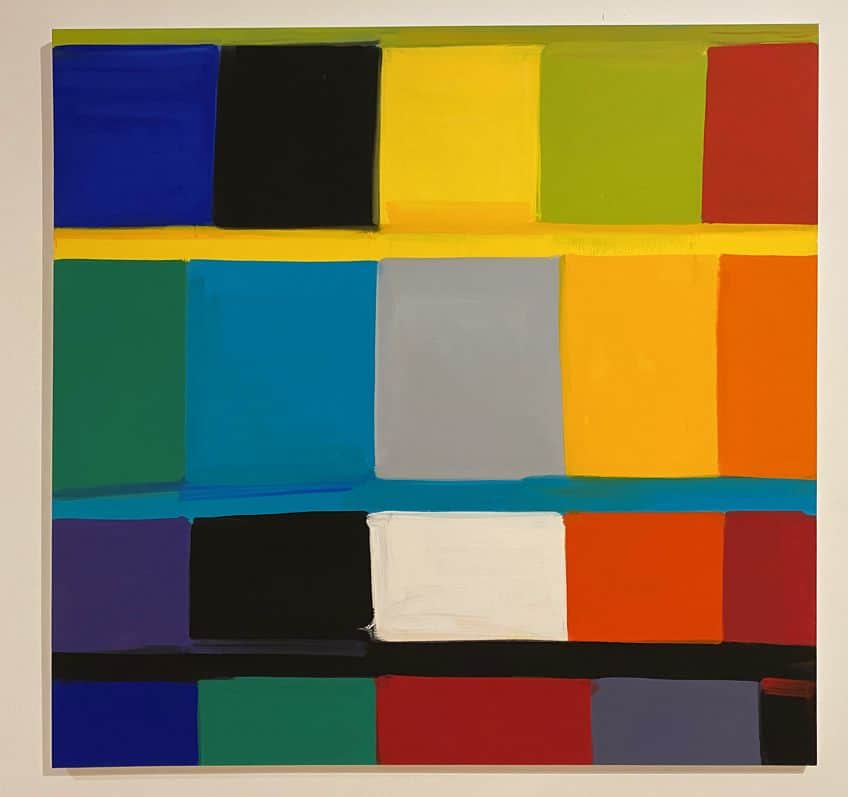Stanley Whitney – A Master in Contemporary Abstraction
Stanley Whitney is a renowned American abstract painter known for his vibrant and dynamic compositions. Born in 1946 in Philadelphia, Whitney’s work is characterized by bold blocks of color arranged in a grid-like format, often exploring the interplay of light and space within the confines of his canvases. His distinctive use of color and geometry creates rhythmic and harmonious compositions that invite viewers to explore the nuances of form and texture. Whitney’s career spans several decades, during which he has exhibited extensively both nationally and internationally, cementing his place as a significant figure in contemporary abstract art.
Table of Contents
Key Takeaways
- Stanley Whitney’s abstract paintings are characterized by vibrant grids of color, reflecting a range of influences from jazz to ancient symbols.
- Whitney’s work is marked by a methodical painting process and evolved from a rich history of exploration and cultural engagement.
- Whitney has secured a significant place in the art world, with increased institutional recognition and retrospectives celebrating his contribution to contemporary abstraction.
Early Life and Education
| Birth | 1946 |
| Death | Present |
| Place of Birth | Philadelphia, Pennsylvania, United States |
| Genre of Work | Geometric painting |
Stanley Whitney is an influential figure in the contemporary art scene, renowned for his distinctive abstract paintings that feature grids of vibrant color blocks and bars which evoke a sense of rhythm and harmony. Rooted in the traditions of American abstraction, Whitney’s works are celebrated for their bold use of color and for the way they resonate with a diverse range of inspirations, including jazz music and Egyptian hieroglyphs. His methodical approach to painting often begins with a horizontal band that sets the structure for the layers of color that follow, invoking a comparison to a bricklayer’s precision and patience.
Having spent decades honing his craft, Whitney’s oeuvre represents a persistent exploration of color theory and compositional balance. His career has been marked by a gradual rise to prominence, experiencing a significant upswing in critical and institutional recognition in recent years. This recognition was punctuated by a long-overdue retrospective that not only showcased his trademark canvases but also highlighted his journey as an artist – a journey that reflects the challenges and cultural shifts in American history.
Art School Experience
Whitney attended the Kansas City Art Institute and later the prestigious Yale University, where he honed his skills and developed a foundation for his artistic career. Striving for academic excellence, he graduated from the Columbus College of Art and Design in 1966.
Influential Figures and Movements
During his studies, Whitney came under the influence of iconic artists such as Giorgio Morandi, Donald Judd, and Piet Mondrian, whose emphases on structure and space would later echo in his own work.
The vibrant art scene of New York City and the historical depth of Rome, Italy, further exposed him to diverse artistic currents.
Development of Artistic Style
Whitney’s style is heavily marked by Abstraction and the complexity of color interactions. He has been vocal about the influence of Jazz on his work, likening the improvisational element of Jazz to his own process of layering grids and colors.
Teaching and Mentorship
After establishing his practice, Whitney chose to impart knowledge and guidance to emerging artists. His teaching career included stints in prestigious institutions, where he often reiterated the importance of being true to one’s artistic vision.

Current Career
Presently, Stanley Whitney is recognized for his vibrant grid-based paintings that straddle the line between randomness and order. The artist continues to exhibit internationally, with recent events showcasing a culmination of years of experimentation and refinement in his craft.
Artistic Themes and Techniques
Stanley Whitney has crafted a distinctive approach to painting, characterized by a vibrant interplay of color and structure. His work is a conversation of forms, delivering a rhythmic visual experience deeply rooted in abstract traditions.

Exploration of Color and Composition
Stanley Whitney’s paintings are celebrated for their exuberant use of color and masterful composition. Each canvas serves as a dynamic field where blocks and bars of color engage in a visual dialogue. Whitney forgoes traditional perspective, opting instead to layer colors in a way that suggests both depth and movement, creating a horizontal band structure that invites viewers to navigate across the painting.
Influences of Jazz and American Quilt-Making
Jazz music, with its improvisational structure and rhythm, significantly informs Whitney’s work. The painter often draws parallels between the spontaneous yet cohesive qualities of jazz composition and his painting technique, likening his process to the rhythmic improvisations of Miles Davis and Ornette Coleman.
Similarly, the rich heritage of American quilt-making translates into his art through a patchwork-like assembly of colors, where each swatch contributes to a harmonious whole.
Grids and Geometries
A fundamental aspect of Whitney’s works is the use of a grid, which underpins the linear structure of his paintings. Unlike the rigid frameworks seen in the works of, for example, Piet Mondrian, Whitney’s grids are characterized by a sense of freedom and fluidity. The grid in his paintings is the armature on which colors dance; it is the scaffold that supports the intricate rhythmic patterns. This approach to abstraction is less about confining and more about arranging hues in a way that each element responds to its neighbor, creating a chromatic call-and-response within the pictorial space.
Major Works and Exhibitions
This section delves into the significant artworks and exhibitions of Stanley Whitney, with a focus on his vibrant, abstract paintings, influential shows, and key contributions to the art world.

Significant Paintings and Series
Stanley Whitney’s artwork is known for its dynamic use of color and grid-like compositions. His notable series, Dance the Orange, exhibited at the Studio Museum in Harlem received critical acclaim for its masterful balance of structure and spontaneity. Whitney’s expressive use of oil paint allows each piece to resonate with rhythmic qualities often likened to musical composition.
National and International Exhibitions
Throughout his career, Whitney has been featured in numerous exhibitions both nationally and internationally. Notable shows include his presence as an official participant in the Biennale Arte 2022 in Venice, Italy.
In the United States, he has shown his work at the Studio Museum in Harlem, and his 2024 presentation at the Buffalo AKG Art Museum is a testament to his standing in the New York art scene.
Collections and Retrospectives
Retrospective exhibitions highlight the span of Stanley Whitney’s work, including his most recent canvases at institutions like the Buffalo AKG Art Museum and the Baltimore Museum of Art, displaying a robust collection of his drawings, prints, and sketchbooks as well. These retrospectives are significant in showcasing the evolution of Whitney’s style and technique over the years.
Collaborations and Partnerships
Whitney has collaborated with several notable artists and galleries. His relationship with Marina Adams stands out, a partnership that explores the conversation between their practices. Renowned galleries like Gagosian, Lisson Gallery, and Karma Gallery have represented Whitney’s work, helping to solidify his influence and expand his reach within the contemporary art world.
The concept of Call and Response can be seen in his collaborative approach, engaging in an artistic dialogue through his exhibitions.
Legacy and Impact
Stanley Whitney’s work has significantly influenced contemporary art with his unique approach to abstract painting, earning accolades and inspiring a wave of young artists.
Contribution to Contemporary Art
Stanley Whitney has been a seminal figure in the realm of contemporary abstract painting. His distinctive use of color and the grid structure has advanced the language of abstraction. Renowned for his colorist approach, he composes using blocks and bars that foster a dialogue within each canvas. Whitney’s paintings resonate with the influences of American quilt-making, jazz, and the work of Piet Mondrian, enhancing the vibrancy and dynamism of contemporary art.
Influence on Emerging Artists and Community
Whitney’s influence extends beyond galleries and museums into the community and among emerging artists. He has played a vital role in mentoring younger talent, including notable African American artist Adam Pendleton.
Through his teaching at various institutions and his active engagement in New York’s and Rome’s art communities, Whitney helps shape the next generation of artists, emphasizing the importance of abstract art as a medium of expression.
Recognition and Awards
- Solo exhibitions: Whitney’s work has been showcased in numerous solo exhibitions worldwide, as well as a museum retrospective at the Buffalo AKG Art Museum in 2024.
- Academic posts: He has held respected teaching positions, sharing his knowledge with students of the fine arts.
Through his exhibitions and teaching roles, Whitney’s mastery and dedication to abstract art have been formally recognized, consolidating his impact on the field.
Stanley Whitney Today
As of 2024, Stanley Whitney continues to be an active force in the art world. His latest works exhibit his ongoing exploration of color and form. His diverse inspirations, coupled with his experimental approach, maintain his relevance in contemporary dialogues about abstract painting. Through exhibitions such as How High the Moon at the Buffalo AKG Art Museum, Whitney’s art remains at the forefront, engaging audiences and sparking critical conversations within the American and international art sphere.

Stanley Whitney’s artistic journey is a testament to his unwavering commitment to exploring the expressive potential of color and form. Through his bold compositions and innovative use of geometric arrangements, Whitney has left a lasting impact on the world of abstract art. His work continues to inspire and challenge viewers, inviting them to engage with the power and beauty of abstract expressionism. As Whitney’s legacy unfolds, it is evident that his contributions to the art world will remain influential and timeless for generations to come.
Frequently Asked Questions
What Are the Significant Themes Present in Stanley Whitney’s Artworks?
Stanley Whitney’s work is recognized for its bold use of color and exploration of geometric structure, often focusing on grids and color fields. His compositions are influenced by musical rhythms and improvisations, reflecting a deep engagement with jazz.
Which Museums Have Featured Stanley Whitney’s Exhibitions?
The Buffalo AKG Art Museum has notably featured Stanley Whitney’s work in a major retrospective survey exhibition. This retrospective, including a comprehensive display of his paintings and other works, marks an important recognition of Whitney’s fifty-year career in the arts.
How Has Stanley Whitney’s Style Evolved Over the Course of His Career?
Over his career, Stanley Whitney’s style evolved through phases of experimentation, often leading towards an abstract expression that utilizes a grid structure to organize color. Beginning with his earlier works from the 1970s up to his most recent canvases, Whitney’s style has embraced a looser, more powerful abstraction while maintaining a distinctive, rhythmic use of color and form.
Isabella studied at the University of Cape Town in South Africa and graduated with a Bachelor of Arts majoring in English Literature & Language and Psychology. Throughout her undergraduate years, she took Art History as an additional subject and absolutely loved it. Building on from her art history knowledge that began in high school, art has always been a particular area of fascination for her. From learning about artworks previously unknown to her, or sharpening her existing understanding of specific works, the ability to continue learning within this interesting sphere excites her greatly.
Her focal points of interest in art history encompass profiling specific artists and art movements, as it is these areas where she is able to really dig deep into the rich narrative of the art world. Additionally, she particularly enjoys exploring the different artistic styles of the 20th century, as well as the important impact that female artists have had on the development of art history.
Learn more about Isabella Meyer and the Art in Context Team.
Cite this Article
Isabella, Meyer, “Stanley Whitney – A Master in Contemporary Abstraction.” Art in Context. May 10, 2024. URL: https://artincontext.org/stanley-whitney/
Meyer, I. (2024, 10 May). Stanley Whitney – A Master in Contemporary Abstraction. Art in Context. https://artincontext.org/stanley-whitney/
Meyer, Isabella. “Stanley Whitney – A Master in Contemporary Abstraction.” Art in Context, May 10, 2024. https://artincontext.org/stanley-whitney/.











